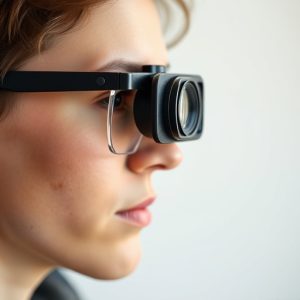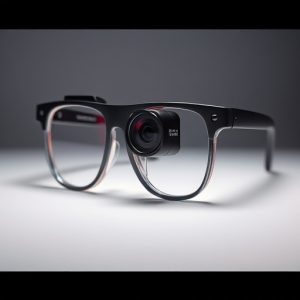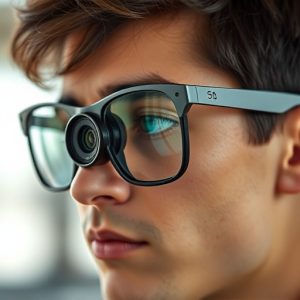Navigating Camera Quality in Glasses with Built-In Optics
The advent of glasses with a camera built-in has revolutionized personal and professional image and…….
The advent of glasses with a camera built-in has revolutionized personal and professional image and video capture, transforming everyday eyewear into sophisticated wearable computing devices. These smart glasses blend advanced imaging sensors and miniaturized camera components to offer high-definition recording capabilities in a comfortable, stylish package. Users can now enjoy unobtrusive document scanning, life recording, and augmented reality experiences with a natural perspective, thanks to the integration of facial recognition, real-time image processing, and privacy features like manual camera activation. As these devices continue to evolve, they promise even more advanced functions, signaling a future where seamless wearable technology enhances daily experiences on a global scale. When selecting such glasses, it's crucial to consider the camera's resolution, field of view, battery life, privacy features, and aesthetic integration. Additionally, factors like lens adaptability to different lighting conditions, data transfer compatibility, and optical quality are key to ensuring both comfort and superior video quality. Leading brands like Sony and Apple have set new standards with their high-definition optics and sophisticated software algorithms, providing consumers with a range of options that balance functionality with style. These smart glasses not only serve as a tool for professionals in real estate, journalism, and remote assistance but also as a personal documenter for capturing life's moments, assisting in education, and offering visual aid for those with impairments. Their versatility and utility make them an indispensable innovation for a wide array of applications.
In recent years, the convergence of optical technology and camera mechanics has given rise to innovative eyewear solutions. This article delves into the fascinating evolution of glasses camera technology, exploring how these devices have become more sophisticated and integrated. We will examine key features that discerning users should consider when selecting glasses with a camera built in, compare optical quality benchmarks among top brands, and discuss the transformative effects of miniaturized components on prescription lenses. Furthermore, we will explore practical applications and use cases for these multifunctional glasses, providing valuable insights into how they enhance daily experiences. Join us as we bring into sharp focus the intersection of vision correction and cutting-edge photography.
Understanding the Evolution of Glasses Camera Technology
The advent of glasses equipped with cameras has marked a significant milestone in wearable technology, reflecting a trajectory of innovation that continues to converge the realms of computing and augmented reality. Initially conceived as simple vision-correcting devices, glasses have transformed into versatile platforms incorporating miniaturized cameras capable of capturing high-definition images and video. The evolution of this technology is rooted in the miniaturization of camera components and advancements in imaging sensors, which have enabled manufacturers to integrate such capabilities seamlessly into eyewear without compromising on comfort or style. As a result, users can now effortlessly record moments, scan documents, or even navigate using built-in cameras in glasses, all while maintaining the natural field of view that traditional handheld cameras cannot offer.
The rapid development of glasses with a camera built in has been propelled by both technological breakthroughs and consumer demand for more intuitive and less obtrusive recording devices. This progression is evident when comparing early iterations with modern examples, which boast features like facial recognition, augmented reality overlays, and real-time image processing. The integration of these sophisticated functions has made the glasses camera not just a tool for capturing memories but also a valuable aid in enhancing daily tasks, providing a glimpse into how wearable technology will continue to evolve, offering even more integrated and seamless experiences for users worldwide.
Key Features to Look for in Glasses with Built-In Cameras
When exploring options for glasses with a camera built-in, it’s crucial to consider several key features that can impact both your comfort and the quality of the footage captured. Firstly, the resolution of the camera is paramount; higher resolutions like 1080p or 4K will deliver crisper and more detailed images. Additionally, the field of view should be wide enough to capture a broad perspective without distortion, ensuring that what you see through the lenses is accurately recorded. For those who prioritize privacy, look for models with manual camera activation, giving you control over when the camera is recording. Battery life is also a significant factor; glasses equipped with cameras that offer extended usage on a single charge are preferable to avoid frequent recharging.
Another important aspect to consider is the integration of the camera within the frame of the glasses. The best designs are inconspicuous, making it seem as though the camera isn’t there at all. This not only maintains a stylish appearance but also reduces the likelihood of unwanted attention or privacy concerns. Furthermore, the type of lens you choose can complement the camera feature; photochromic or prescription lenses that adapt to lighting conditions can enhance the overall user experience by providing clarity and comfort without interfering with the camera’s functionality. Lastly, compatibility with various platforms and devices for easy data transfer and storage is a valuable feature, allowing users to seamlessly share their experiences or save them as needed. By carefully evaluating these features, you can select a pair of glasses with a camera built-in that not only meets your visual needs but also captures high-quality footage effortlessly.
Comparing the Optical Quality of Camera Glasses Across Different Brands
When evaluating the optical quality of cameras with integrated glasses, discerning consumers are often faced with a myriad of options across various brands. The convergence of camera and eyewear technology has led to a competitive market where each brand strives to offer the best visual experience. For instance, brands like Sony with their “Sony Glasses with a Camera Built-In” series have made strides in providing high-definition optics that rival traditional standalone cameras. These glasses offer sharp imagery and accurate color representation, catering to enthusiasts who value both functionality and style. Meanwhile, competitors such as Apple’s “Apple ProGlass” boast advanced lenses that optimize for clear visuals and efficient recording capabilities. The comparison between these models often hinges on the balance between lens clarity and the field of view, which is critical for capturing immersive footage without compromising on the wearer’s natural sight. Additionally, factors such as image stabilization, low-light performance, and the integration of software algorithms to enhance image quality are key differentiators that set top-tier camera glasses apart from their counterparts. Consumers looking for the pinnacle of optical quality in a camera glass product must weigh these features against their specific needs and preferences, ensuring they select a pair that not only captures high-quality footage but also maintains the comfort and functionality expected from premium eyewear.
The Impact of Miniaturized Camera Components on Prescription Lenses
The advent of miniaturized camera components has revolutionized the design and functionality of prescription lenses, particularly in the realm of glasses with a camera built in. Traditional eyewear has undergone a significant transformation as manufacturers integrate advanced optical technology within the confines of slim, unobtrusive frames. This integration enables wearers to seamlessly capture images or record videos without the need for additional devices, thus enhancing both convenience and style. The tiny, high-resolution cameras embedded in these lenses are a testament to technological innovation, offering sharp imagery that rivals standalone camera quality. The compact nature of these components allows for a more comfortable fit, as well as a lighter weight, which is crucial for all-day wear. Moreover, the integration of cameras into prescription lenses has led to improvements in the overall lens technology, pushing the boundaries of what is possible with corrective eyewear. The miniaturization process not only reduces the footprint of the camera but also refines the precision of the lenses, ensuring that vision correction and photography can coexist harmoniously. This dual-functionality opens up new possibilities for both professional photographers and everyday users who value both clarity of vision and the ability to document their surroundings instantly. As a result, glasses with a camera built in are becoming increasingly popular, signaling a shift towards smart eyewear that caters to a wide range of users with diverse needs.
Practical Applications and Use Cases for Glasses with Integrated Cameras
Glasses equipped with integrated cameras have become increasingly sophisticated, offering a myriad of practical applications across various domains. For instance, professionals in fields such as real estate, journalism, and even remote assistance can leverage these devices to capture high-resolution images and videos directly from their perspective. This technology allows for immersive virtual tours, live reporting with a first-person view, and the ability to provide instant visual support without the need for additional cameras or equipment.
Moreover, in the realm of personal use, glasses with a camera built in can enhance daily experiences by enabling users to document life’s moments as they unfold, ensuring that significant events are not missed. These wearable devices also cater to the education sector, where educators can record lectures and students can record lessons for review. Additionally, for those with visual impairments, these glasses can provide enhanced vision capabilities, coupled with the ability to capture their surroundings for later analysis. The integration of augmented reality (AR) into this technology further expands its utility, offering real-time data overlay for various activities, from navigation to sports coaching. This fusion of camera and AR capabilities within a compact, wearable device opens up a world of possibilities, making it an invaluable tool for both work and personal enrichment.


